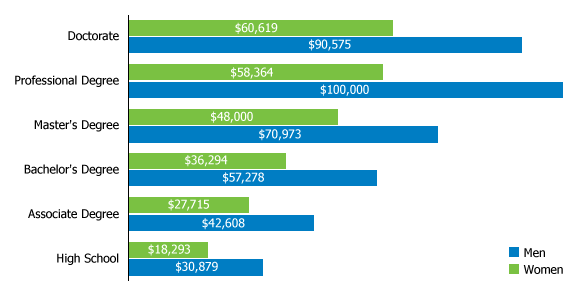
College Education Benefits Some More Than Others
(September 2010) Most American schoolchildren are familiar with the pressure to prepare for college. They hear about the importance of a college education from parents and teachers beginning in elementary school, and the appeals to work hard toward that goal escalate in secondary school. Does the effort pay off? Research confirms that it does, and a new study finds that getting a college education is even more valuable for students from disadvantaged backgrounds—those who are least likely to attend.1
Research by Jennie E. Brand of the University of California-Los Angeles and Yu Xie of the University of Michigan found that the financial return from a college degree is three times higher for men from a disadvantaged background than for more privileged men. For women, college was twice as valuable for the disadvantaged group. College yielded a lower return for Americans from more privileged backgrounds presumably because they had advantages through their families and social standing that also conferred valuable opportunities.
The UCLA-led study was based on a survey of nearly 13,000 Americans who were 14 to 22 years old in 1979, and were followed until 2008. Consistent with other data, the researchers found that the young people most likely to go to college came from families and a social network that valued college. Their parents had attended college and their friends were also planning to go. They were more likely to be from upper-income families and were high achievers in high school. African Americans and Latinos in the study were less likely to have the family, educational, or social backgrounds that favored college attendance, and they were less likely to enroll.
But disadvantaged students who did overcome these hurdles reaped big returns. The “college bonus” for these students stemmed in part from the deteriorating income and opportunities for less-educated workers. With the decline of manufacturing jobs and other economic changes, the average incomes have stagnated or declined in real terms for people with a high school education in recent decades.2 Children of working-class families who invested in a college education had a much wider range of career options than family and friends who did not attend college.
Thus, the motives for college attendance for the disadvantaged and privileged groups differed. Brand, the study’s lead researcher, hypothesized that “for students from disadvantaged groups, college is a novelty that demands economic justification. By contrast, for students from advantaged backgrounds, college is a culturally expected norm.”
Median Income for Selected Education Levels, Men and Women Ages 25 Years or Older, 2008

Source: U.S. Census Bureau, Current Population Survey, Annual Social and Economic Supplements, accessed at www.census.gov/hhes/www/income/data/historical/people/p16.xls, on Sept. 9, 2010.
U.S. College Enrollment Expanding
The study’s findings underscore the value of expanding college enrollment for Americans, especially those from families with a lower socioeconomic status. There are many options for post-high school study in the roughly 4,500 institutions of higher education in the United States. About 30 percent of the degree-granting institutions are two-year colleges, such as relatively inexpensive community colleges. The cost of a public two-year college was less than $8,000 in the 2009-2010 academic year for students living at home. Two-year for-profit colleges are much more expensive, an average of $20,000 per year, almost as much as a four-year private university ($24,000 per year for students living at home, and $34,000 for those living on campus).3
While the top universities are accessible only to the most outstanding students, the vast majority of institutions accept students with average or even below-average records, making college a possibility for most people, assuming they can overcome financial constraints.
In fact, most U.S. students go on to college after high school. The percentage reached its highest level ever in 2009 when 70 percent of high school graduates ages 16 to 24 were enrolled in an institution of higher education.4 From the 1950s through the 1970s, barely one-half of high school graduates went to college, but both high school graduation rates and college attendance have increased since then.
Data from the U.S. Census Bureau illustrate the financial value of completing higher education—which rises incrementally with each level (see figure). In 2008, a man with a professional degree, typically in law or medicine, earned about $100,000, compared with about $31,000 for a male high school graduate. A doctoral degree brings higher incomes than the next level down, a master’s degree. Even a two-year associate degree confers an income advantage for both men and women, and seems to validate the entreaties by teachers and parents for U.S. schoolchildren to work toward college, even if they are not destined for the Ivy League.
Mary Mederios Kent is senior demographic writer at the Population Reference Bureau.
References
- Jennie E. Brand and Yu Xie, “Who Benefits Most From College? Evidence for Negative Selection in Heterogeneous Economic Returns to Higher Education,” American Sociological Review 75, no. 2 (2010): 273-302.
- U.S. Census Bureau, “Current Population Survey, Annual Social and Economic Supplements, Table P-16: Educational Attainment—People 25 Years Old and Over by Median Income and Sex: 1991 to 2008,” accessed at www.census.gov/hhes/www/income/data/historical/people/p16.xls, on Sept. 9, 2010.
- L.G. Knapp, J.E. Kelly-Reid, and S.A. Ginder, Postsecondary Institutions and Price of Attendance in the United States: Fall 2009, Degrees and Other Awards Conferred: 2008-09, and 12-Month Enrollment: 2008-09 (Washington, DC: National Center for Education Statistics, 2010), accessed at http://nces.ed.gov/prbsearch, on Aug. 31, 2010.
- Bureau of Labor Statistics, The Editor’s Desk: College Enrollment Up Among 2009 High School Grads (April 28, 2010), accessed at www.bls.gov/opub/ted/2010/ted_20100428_data.htm, on Sept. 9, 2010.
